Hiking Gloves Choosing Right
Ever find yourself on a trail, mesmerized by the beauty of nature, but distracted by the nagging discomfort in your hands? I have, and trust me, the right pair of hiking gloves can make a world of difference.
Why Hiking Gloves Are Essential
Hiking is an adventure that brings us closer to nature, challenges our physical limits, and provides a sense of accomplishment. However, to fully enjoy these experiences without unnecessary interruptions, it’s crucial to equip ourselves properly, and this includes wearing the right pair of hiking gloves. Let’s delve into why hiking gloves are not just an accessory but an essential gear for every hiker.
Protecting Your Hands
Our hands are incredibly versatile tools, capable of performing a wide range of tasks, yet they are also among the most vulnerable parts of our bodies when exposed to the elements and rough terrains. Here’s why protection is paramount:
- Prevention of Cuts and Scrapes: The wilderness is filled with potential hazards for your hands, from thorny bushes to jagged rocks. Hiking gloves act as a protective barrier, reducing the risk of skin injuries.
- Shielding Against the Cold: In cooler climates or high altitudes, temperatures can plummet, leaving your hands susceptible to cold. Gloves provide insulation, keeping your fingers warm and functional.
- Protection from Sunburn: On sunny days, the back of your hands can suffer from sunburn. Many hiking gloves come with UV protection to guard against harmful rays.
Enhancing Grip and Comfort
The physical challenges of hiking demand not just endurance but also stability and grip, especially on uneven or slippery terrain. Here’s how hiking gloves can make a difference:
- Improved Grip: Sweaty palms can compromise your hold on rocks, trekking poles, or even the ground itself during steep ascents or descents. Gloves designed for hiking are made with materials that enhance your grip, ensuring that slippery hands won’t cause a slip-up.
- Increased Comfort: Long hours of holding onto trekking poles or navigating through rocky paths can lead to blisters and calluses. Gloves cushion your palms, distributing pressure more evenly and preventing skin damage.
- Better Control in Various Conditions: Whether it’s a damp morning trek, a climb over frosty paths, or maneuvering through dusty trails, gloves provide the necessary control by keeping your hands dry and comfortable.
Factors to Consider When Choosing Hiking Gloves
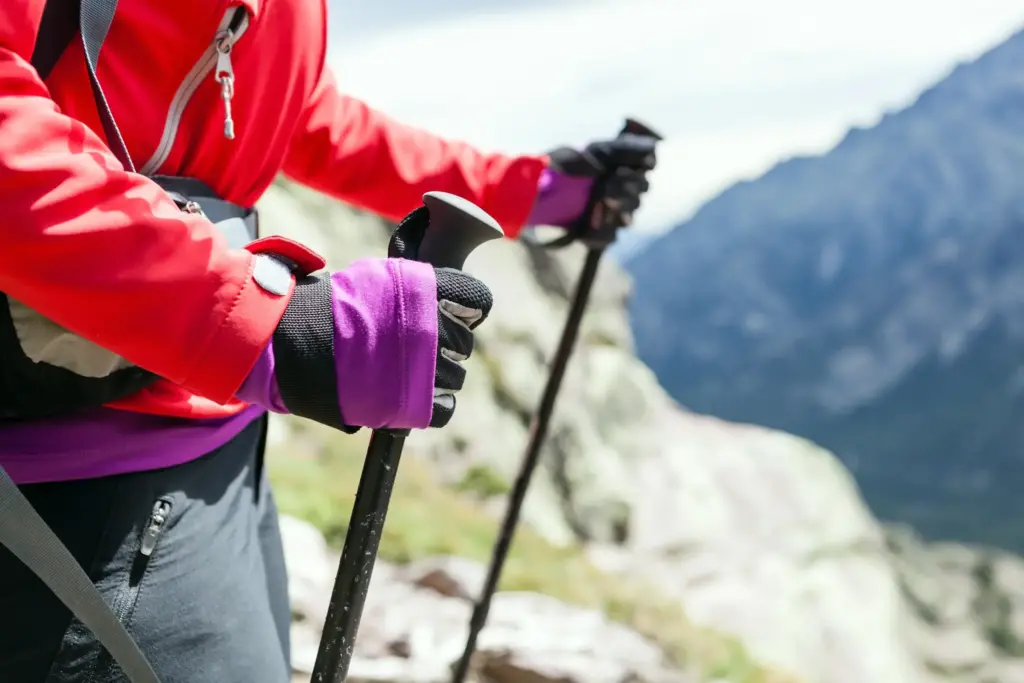
Selecting the right gloves is more than just grabbing the first pair you see on the shelf. Consider the following:
Material
The material of your hiking gloves plays a pivotal role in determining their durability, comfort, and suitability for various conditions.
- Leather: A classic choice, leather gloves offer excellent durability. They mold to the shape of your hands over time, providing a snug fit. However, they can be heavier and might need more maintenance, like occasional conditioning, to keep them in prime condition. They’re generally more water-resistant than water-proof.
- Synthetic: Often made from materials like polyester or nylon, synthetic gloves are lightweight and dry quickly when wet. They can be more breathable than leather and often come with a lower price tag. The trade-off is that they might not be as durable in the long run, especially against rough terrains.
- Fleece: Perfect for colder conditions, fleece gloves provide excellent insulation. However, they might not be the best for wet conditions unless they have a waterproof lining.
Fit and Sizing
Ensuring a proper fit is crucial not just for comfort but also for functionality:
- Measuring Your Hand: Use a soft tape measure. Wrap it around your dominant hand at the widest part, excluding the thumb. This gives you the circumference. Most brands will have a size chart correlating hand size to glove size.
- Checking the Fit: The glove should fit snugly but not restrict movement. You should be able to make a fist without feeling the material stretching significantly. Pay attention to the length of the fingers; they shouldn’t be too long or too short.
- Potential Problems with Ill-fitted Gloves: A glove that’s too tight might restrict blood flow, leading to cold hands. Conversely, a loose glove can cause blisters due to friction and might not provide effective insulation.
Weather-appropriateness
It’s not just about cold or hot weather; it’s about understanding the nuances:
- Waterproof vs. Water-resistant: Waterproof gloves are impermeable to water, even when submerged (to an extent). Water-resistant gloves can handle light rain or snow but might get soaked in heavy downpours.
- Insulation: For cold weather, look for gloves with proper insulation. Materials like Thinsulate provide warmth without bulkiness.
- Breathability: In hot weather, or for strenuous hikes, breathability is crucial. Look for gloves with ventilation features or those made from breathable fabrics.
- UV Protection: If hiking in sunny conditions, consider gloves that offer UV protection. They shield your hands from harmful UV rays, preventing sunburn.
Durability and Dexterity
Your gloves should be sturdy enough to withstand the rigors of the trail but also allow you the dexterity to, say, tie a shoelace.
Glove Technology
Modern hiking gloves aren’t just fabric stitched together; they come with impressive tech features:
- Touchscreen Fingertips: As we become more reliant on tech, even on trails, many gloves now feature fingertips that allow you to operate smartphones or GPS devices without removing them.
- Heating Elements: For those who venture into freezing conditions, some gloves come with built-in heating elements, powered by batteries, to provide consistent warmth.
- Sweat-wicking: To prevent clammy hands, some gloves feature materials that wick moisture away, keeping your hands dry and comfortable.
- Anti-microbial treatments: This helps in reducing odor and bacterial growth, especially if you’re on long treks and don’t have the luxury to wash your gloves regularly.
My Top Hiking Gloves Recommendations
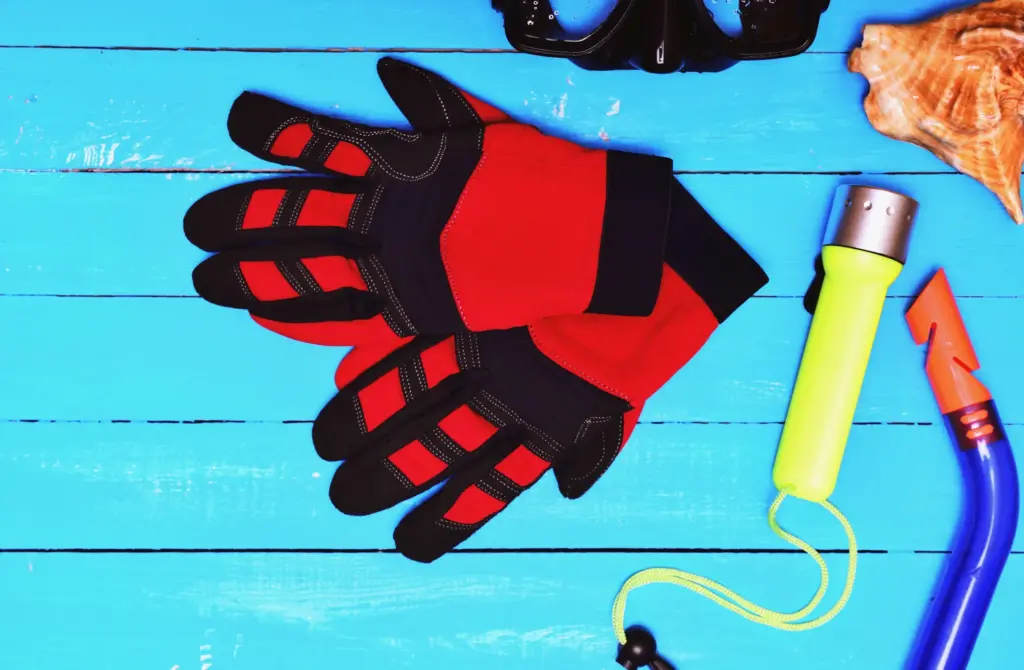
Finding the right pair of gloves can significantly enhance your comfort and performance during outdoor activities. Below, we review six products, each with unique features catering to different needs, from casual hiking to more specialized tasks like ice climbing and tactical operations.
1. SIMARI Winter Gloves
The SIMARI Winter Gloves are a versatile choice, designed for a wide range of activities in cold weather.
Pros:
- Touch Screen Design: Enables easy use of smartphones and GPS devices without removing the gloves.
- Comfortable & Warm: Made with 95% Polyester and 5% Spandex, providing warmth and elasticity.
- No-slip & Humanized Design: Silicone particles on the palm and fingers enhance grip, while reflection patterns increase nighttime safety.
Cons:
- Durability: With regular intense use, the touch screen capability and silicone grip might wear down.
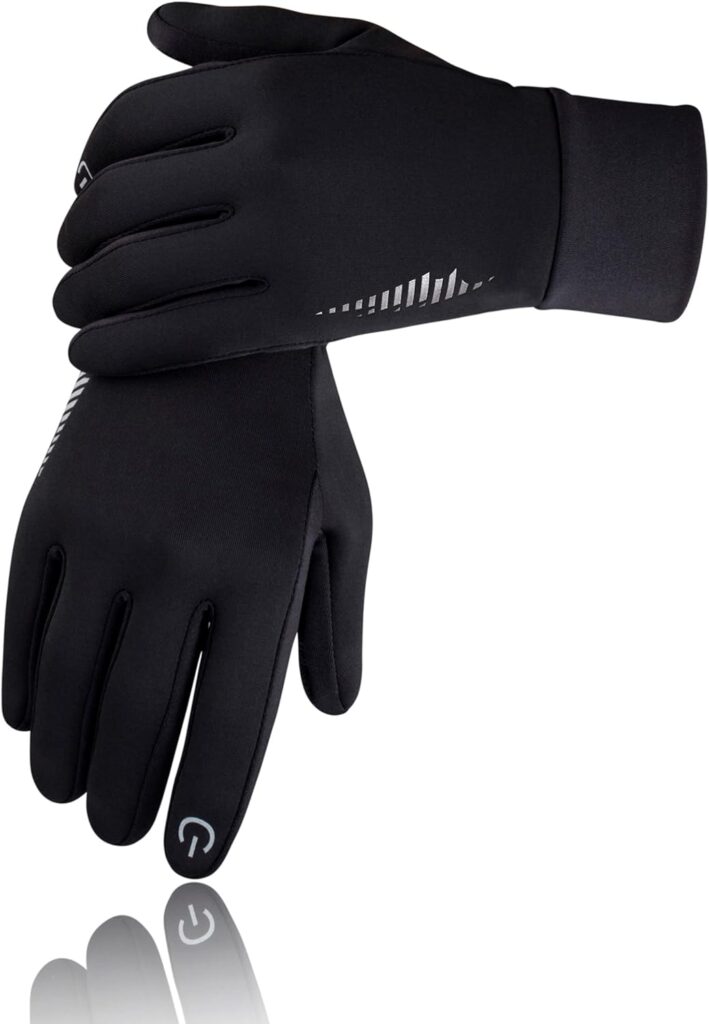
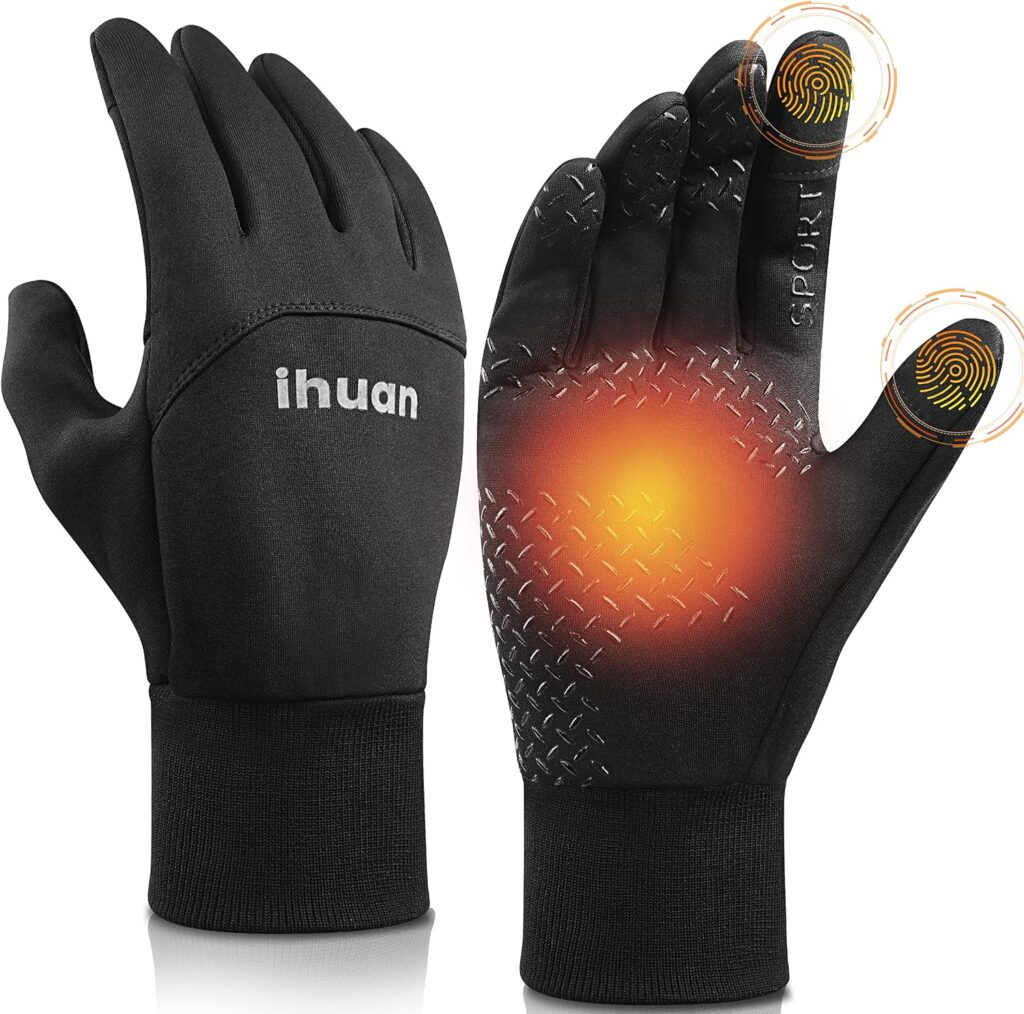
2. ihuan Winter Gloves
Designed for mild winter weather, ihuan Winter Gloves are lightweight and offer a balance between warmth and dexterity.
Pros:
- Waterproof and Windproof: Keeps hands warm and dry in cold, wet conditions.
- Anti-Skid Silicone Design: Provides a strong grip, even when wet.
- Phone Touchscreen Compatible: Allows for easy device use.
Cons:
- Warmth: May not be sufficient for extreme cold or prolonged outdoor activities in freezing temperatures.
3. TRENDOUX Winter Gloves
TRENDOUX offers a budget-friendly option with their upgraded touch screen cold weather gloves, perfect for running and driving.
Pros:
- High Sensitive Touchscreen: Enhanced conductive yarn for better touch screen interaction.
- Triangle Silicone Anti-Slip: Ensures a firm grip on various surfaces.
- Comfortable and Elastic Cuff: Provides a snug fit, keeping the cold out.
Cons:
- Size and Fit: Some users may find the sizing a bit off, affecting the glove’s overall comfort and touchscreen functionality.
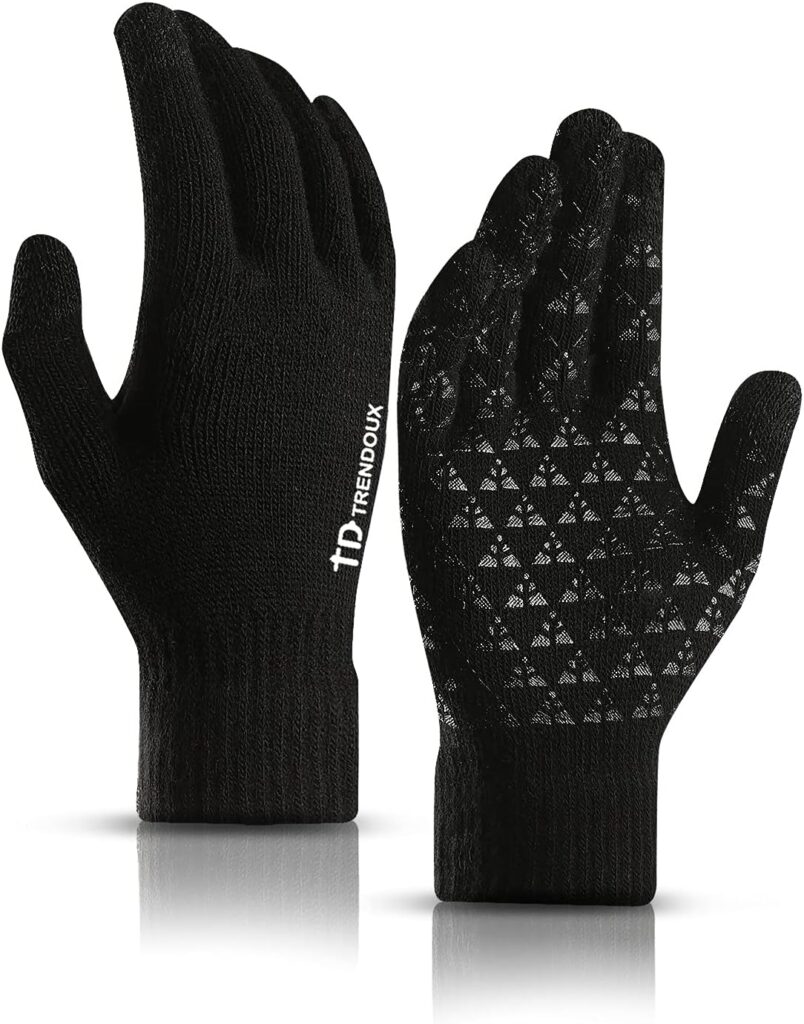
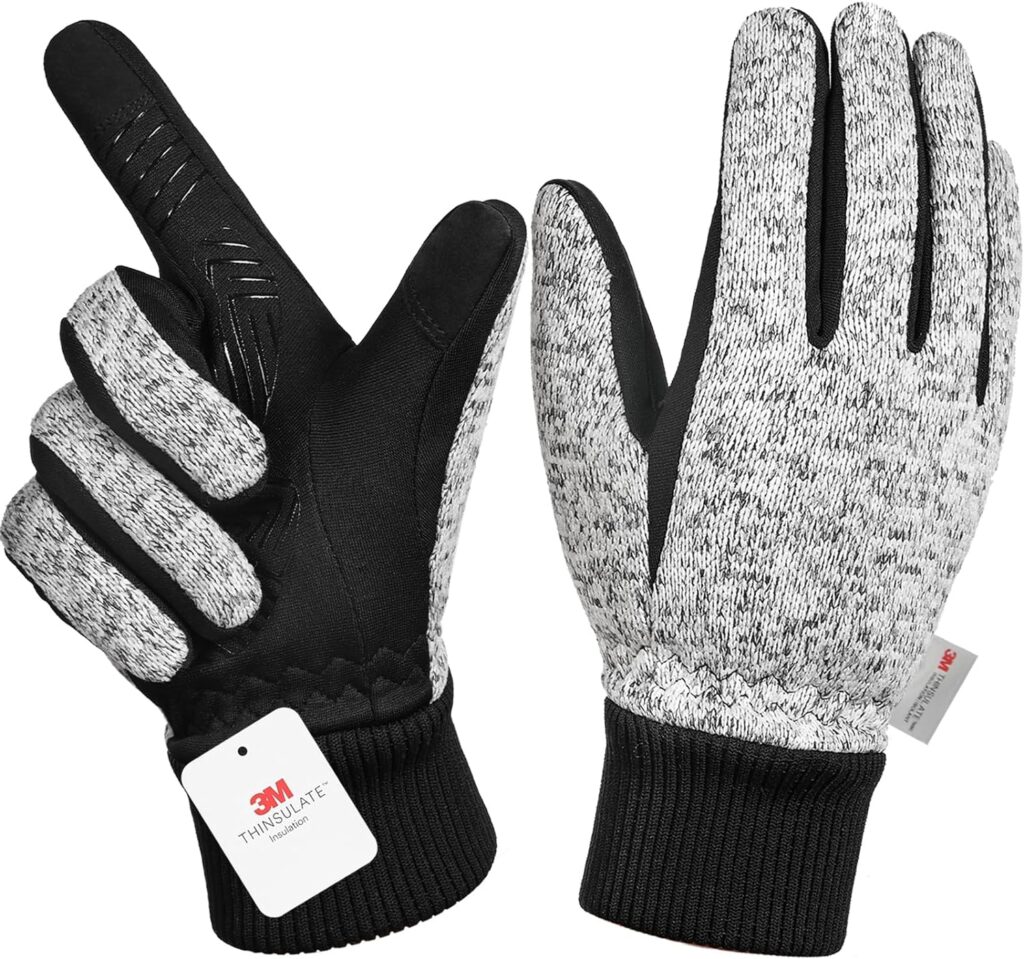
4. MOREOK Winter Gloves
MOREOK gloves are designed for extreme cold, featuring 3M Thinsulate insulation for superior warmth.
Pros:
- Quality Fabrics: Offers excellent heat retention and breathability.
- Sensitive Touch for Smart Screens: Conductive fabric on thumb and index fingers for easy device use.
- Snowproof & Windproof: Ideal for skiing, snowboarding, and other outdoor winter activities.
Cons:
- Size: Tends to run smaller, which might necessitate ordering a size up for a comfortable fit.
5. HYCOPROT Fingerless Tactical Gloves
HYCOPROT Gloves are tailored for outdoor enthusiasts needing tactical protection without sacrificing dexterity.
Pros:
- Lightweight and Durable: Made of 100% knitted nylon, providing breathability and comfort.
- Protection and Flexibility: Fingerless design allows for easy manipulation of equipment and tools.
- Multifunctional: Suitable for a range of activities including hunting, hiking, and motorcycling.
Cons:
- Warmth: Being fingerless, they offer limited protection against cold.
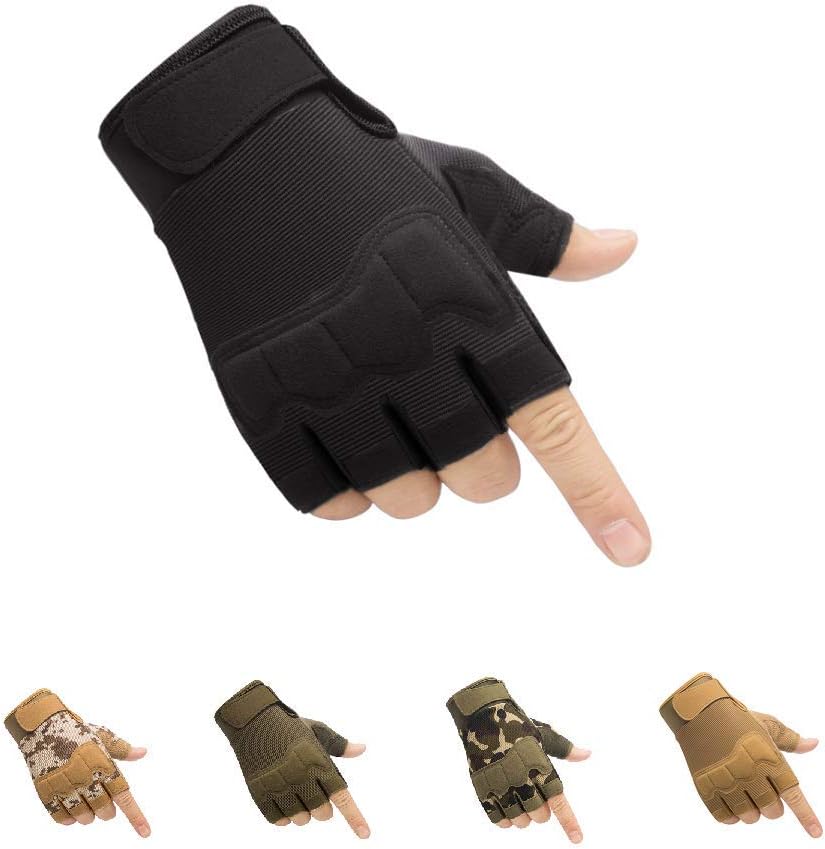
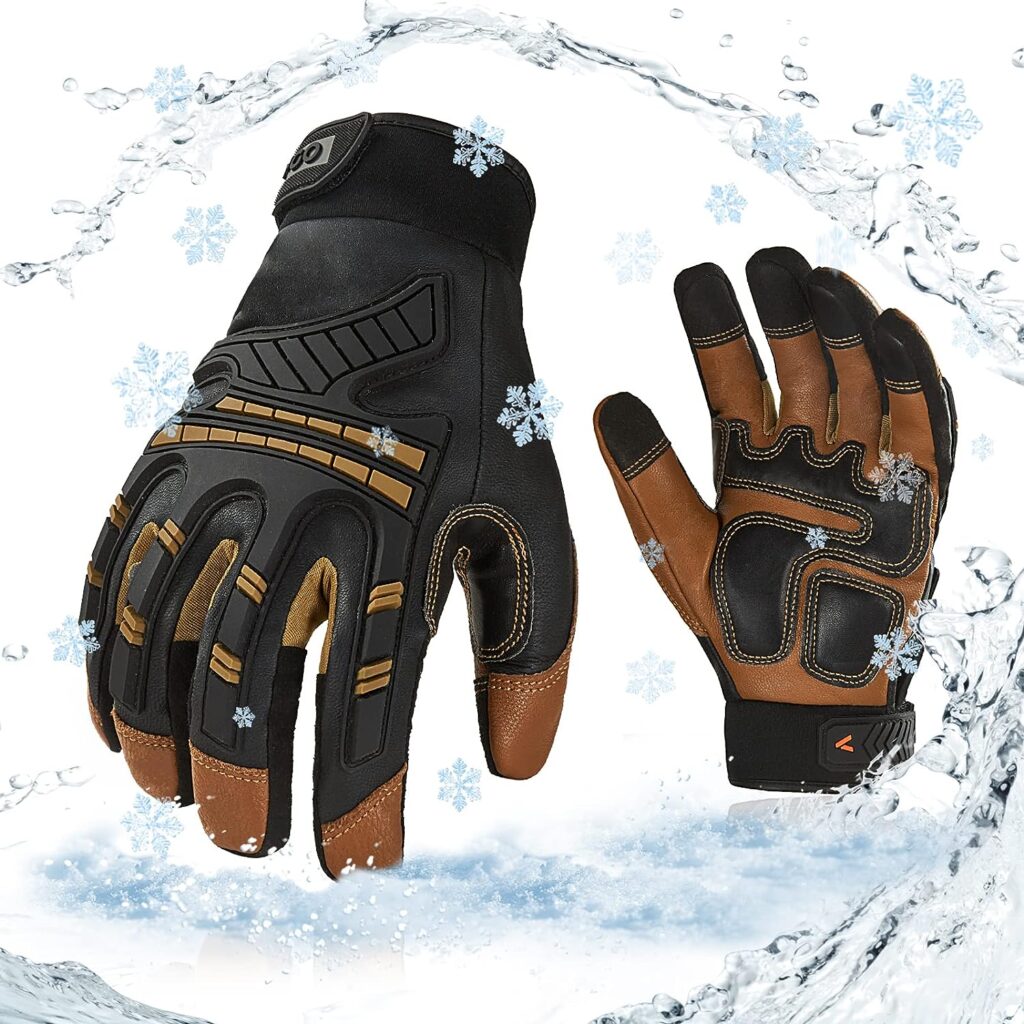
6. Vgo… Winter Waterproof High Dexterity Gloves
Vgo… gloves are heavy-duty, designed for construction, utility work, and outdoor activities requiring high protection in cold conditions.
Pros:
- Premium Material: Genuine goat leather for comfort and dexterity.
- Impact Protection: Thermal Plastic Rubber (TPR) guards protect against impacts and abrasions.
- Waterproof and Insulated: Keeps hands dry and warm, with touchscreen compatibility.
Cons:
- Bulkiness: The added protection and insulation may reduce dexterity for fine tasks.
Tips for Glove Maintenance

Maintaining your hiking gloves is not just about extending their lifespan; it’s also about ensuring they provide the maximum protection and comfort on your hikes. Proper care can prevent minor damages from becoming major issues and keep your gloves in top condition for your next adventure. Below are detailed tips and practices for glove maintenance, designed to help you get the most out of your investment.
Regular Checks
Consistent inspection of your gloves is the first step in maintaining their integrity and functionality. Here’s what to focus on:
- Inspect Before and After Hikes: Make it a routine to check your gloves for any signs of wear and tear. Doing this both before and after hikes ensures you’re always prepared and can address any issues promptly.
- Look Out for Damage: Pay special attention to areas prone to wear, such as the fingertips and palms. Loose stitching, tears, and holes not only compromise the gloves’ protective capabilities but can also worsen over time if not repaired.
Proper Treatment and Cleaning
Different materials require different care strategies. Here’s how to handle the two most common types of hiking gloves:
- Leather Gloves:
- Conditioning: Leather gloves benefit from occasional conditioning to keep the material soft and prevent cracking. Use a leather conditioner as directed on the product label.
- Avoid Direct Heat: When drying leather gloves, avoid placing them near direct heat sources, as this can cause the leather to become brittle.
- Synthetic Gloves:
- Water Repellency Maintenance: Synthetic materials often come with a water-repellent coating that can wear off over time. Use a water-repellent spray designed for synthetic fabrics to restore water resistance.
- Gentle Washing: Wash synthetic gloves according to the manufacturer’s instructions, typically with mild soap and cool water, to remove dirt and sweat without damaging the material.
Understanding Lifespan
The lifespan of your hiking gloves is influenced by several factors, including their quality, the materials they’re made from, and how they’re used:
- Average Lifespan: While a pair of hiking gloves can last anywhere from 1 to 3 years with regular use, this estimate can vary. High-quality gloves made with durable materials and subjected to proper maintenance can last toward the upper end of this range or even longer.
- Intensity of Use: Gloves used in harsh conditions or for more rigorous activities may have a shorter lifespan due to increased exposure to elements and wear.
- Replacement: Be prepared to replace your gloves when they can no longer be effectively repaired or when they no longer provide adequate protection and comfort.
Alternatives to Traditional Hiking Gloves

When it comes to hiking, the right gear can make all the difference in comfort and protection. While traditional full-fingered hiking gloves are a popular choice among outdoor enthusiasts, there are alternative options that cater to specific needs and conditions. Understanding these alternatives can help hikers choose the best hand protection for their adventures. Let’s explore some of these options in more detail.
Mittens
Mittens are an excellent alternative to traditional gloves, especially for those venturing into extremely cold environments. Here’s why they might be a better choice for some hikers:
- Enhanced Warmth: The primary advantage of mittens is their superior warmth. By keeping the fingers together in a single compartment, mittens allow for better heat retention, making them ideal for cold-weather hikes.
- Considerations: While mittens offer increased warmth, they do so at the expense of dexterity. Activities that require fine motor skills, such as tying shoelaces or handling small equipment, may be more challenging.
Glove Liners
Glove liners are a versatile option that can serve as both an addition to traditional gloves and a standalone choice for milder conditions.
- Extra Insulation: Worn underneath your main hiking gloves, liners provide an additional layer of warmth without significantly adding bulk.
- Flexibility for Conditions: In milder weather or during high-exertion activities where you might overheat with full gloves, liners can be worn on their own, offering a balance between warmth and breathability.
- Material Choices: Liners come in a variety of materials, including silk, wool, and synthetic blends, each offering different benefits in terms of warmth, moisture management, and comfort.
Half-finger Gloves
Also known as fingerless gloves, half-finger gloves offer a unique combination of protection and dexterity that full-fingered gloves can’t match.
- Dexterity and Protection: By covering the palms and the base of the fingers while leaving the fingertips exposed, these gloves protect against blisters and abrasion without sacrificing the ability to perform precise tasks.
- Suitability: These gloves are particularly suited for activities where grip and tactile feedback are essential, such as navigating with a compass, using a smartphone, or adjusting backpack straps.
- Limited Warmth: The major drawback of half-finger gloves is their reduced warmth. They are best used in mild conditions or when the primary concern is not cold protection.
Hiking Gloves for Specific Activities
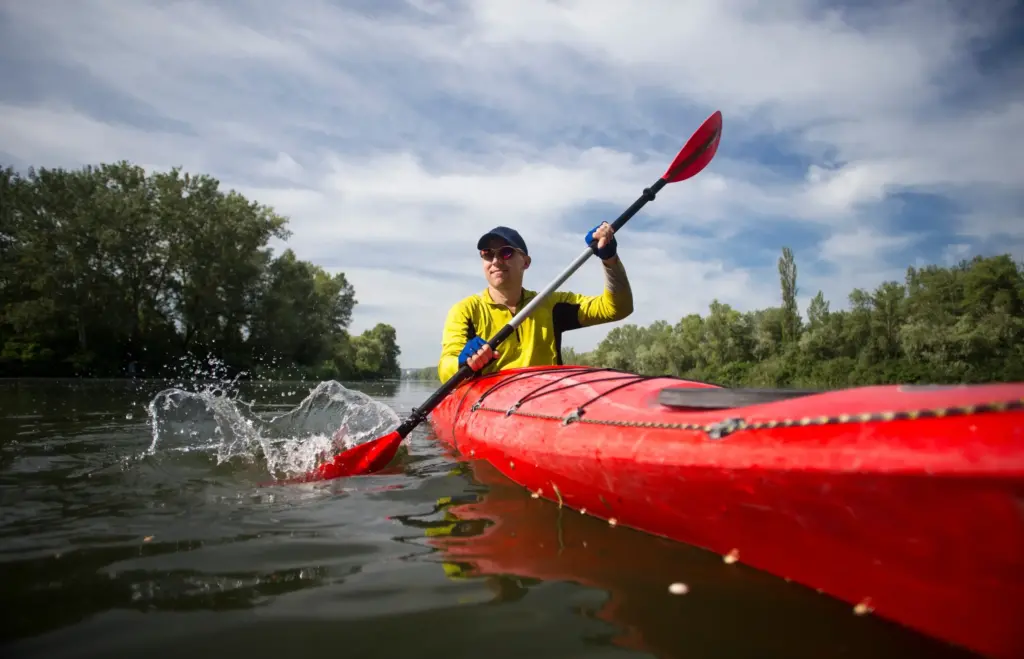
The diversity of outdoor activities often calls for gear tailored to specific conditions and challenges. Hiking gloves are no exception. Depending on the activity, the requirements for gloves can vary significantly, from enhanced grip and durability for rock scrambling to exceptional insulation and water resistance for ice climbing. Below, we delve into the specific needs of gloves for various activities, providing insights into what features to look for to ensure both protection and performance.
Rock Scrambling
Rock scrambling combines hiking with climbing, often involving navigating through rough, rocky terrain. Gloves designed for this activity should have the following characteristics:
- Durability: The gloves need to withstand constant friction against rough surfaces. Look for gloves made with high-strength materials, such as reinforced leather or synthetic fabrics designed for abrasion resistance.
- Grip: A secure grip is crucial for safely maneuvering over rocks. Rubberized palms or textured grip patterns can provide the necessary traction.
- Flexibility and Fit: Gloves should offer enough flexibility to allow for natural hand movements, enhancing your ability to grip rocks securely. A snug fit prevents the gloves from catching on rocks or equipment.
Ice Climbing
Ice climbing demands gloves that can cope with cold, wet conditions while offering the dexterity needed to handle climbing equipment.
- Insulation: Look for gloves with high-quality insulation materials that retain warmth even in extremely cold conditions. Insulation should be balanced with dexterity; too much bulk can impede movement.
- Water Resistance: Waterproof or water-resistant materials are essential to keep hands dry. Wet gloves can lead to a rapid loss of warmth and dexterity.
- Reinforcement: Reinforced palms and fingers protect against wear from ice axes, ropes, and other equipment. Durable materials like leather or synthetic reinforcements can add longevity and protection.
Paddling or Kayaking
Gloves for paddling or kayaking need to perform well in wet conditions, offering both comfort and functionality.
- Superb Grip: A non-slip grip is essential for maintaining control of the paddle, especially when wet. Look for gloves with silicone grips or other materials that provide traction in wet conditions.
- Quick-Drying: Materials that shed water and dry quickly, such as neoprene or quick-dry synthetics, keep hands comfortable and reduce the risk of chafing.
- Sun Protection: For activities on the water, UV protection is an important consideration. Many paddling gloves are made with materials that offer sun protection to guard against UV exposure during long days on the water.
Conclusion
Hiking gloves, my friends, are more than just an accessory. They’re a necessity. Whether you’re a seasoned hiker or just starting out, investing in the right pair will surely elevate your hiking experience. Check or full guide about hiking gear for beginners.
FAQs
- Can I use regular gloves for hiking?
While possible, it’s best to use gloves specifically designed for hiking to ensure optimum protection and comfort. - How often should I replace my hiking gloves?
Depending on wear and tear, a good pair can last several seasons. However, once you notice any signs of damage, it’s time for a new pair. - Are hiking gloves machine-washable?
Always check the label. Some are, while others are strictly hand-wash only. - Do I need different gloves for summer and winter hikes?
Yes, it’s recommended. Summer gloves are typically lighter, while winter gloves offer more insulation. - Is leather or synthetic better for hiking gloves?
Both have their merits. Leather is more durable but can be heavier, while synthetic is lightweight and dries quickly. Choose based on your preference and hiking conditions.
Resources
https://climbingcodex.com/tool-for-climbing-glaciers-mastering-the-art-of-ice-adventure/




